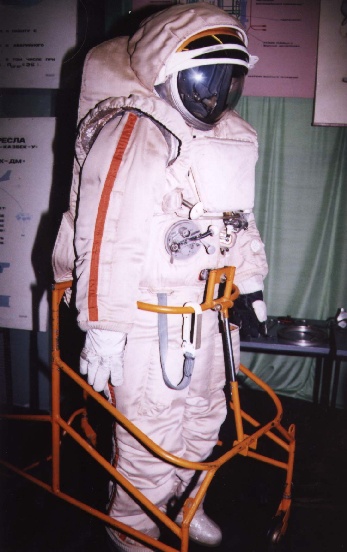
The day I finally met the Krechet suit!
Below are the 2 photos I got of the Krechet suit on display at the Smithsonian Air & Space Museum


Ben Guenther’s NASM Krechet Suit Photos



..
Above: Rare B&W photo of the main control panel for the Krechet suit and, to the right, a diagram showing the full Cyrillic text and the meaning of each label on it.


Above: 2 new photos sent to me by my friend Julius deRoo, of the Netherlands, from his recent space museum tour of Russia. These are color photos from both sides of the Kreceht suit control panel. (Ed: Julius got to put the suit on!)
This spacesuit was designed specifically for the Soviet manned lunar program for the cosmonaut who would have walked on the moon if the program had eventually succeeded. Called “Krechet” (Gyrfalcon or Tamed Falcon), it was designed and built by the Zvezda bureau.
The suit weighed approximately 90 kg/198 lbs (only about 33 lbs on the moon) and was capable of about 10 hours of operation between each consumables reload. The suit was designed to operate for a total of 48 hours, including the two EVA to and from the LOK in lunar orbit.
The suit was the first semi-rigid design ever built, with a hard metallic shell for the torso and (relatively) soft cloth arms and legs. This is the same concept that is now incorporated into both the Russian and American extra-vehicular spacesuits.
Another innovation was the hinged backpack which, when opened, allowed the cosmonaut to climb into the suit through the rear vs. putting it on like a normal suit. This process greatly simplified donning the suit and increased it’s reliability over suits with a more conventional zipper opening.
The control panel can be seen on the chest area of the suit. It had 11 buttons for controlling suit functions and various dials and indicators for suit systems and consumables status. It could be folded out for use or stowed against the chest when the cosmonaut was busy.
One other interesting feature which I read of is the use of a “hoola-hoop” metal ring attached to the cosmonaut’s back. The idea was that, since he was to be alone on the lunar surface, should he fall over and be without assistance to get back up, he could utilize the hoop by simply rolling back over on his side and then using his arms and legs to get back up.
One of the suits, like many other Soviet space artifacts, was sold at auction by Sotheby’s of London. Opening bid was listed at $200,000 – $250,000. I’ve heard that Ross Perot bought it and he plans to someday return it to Russia.
